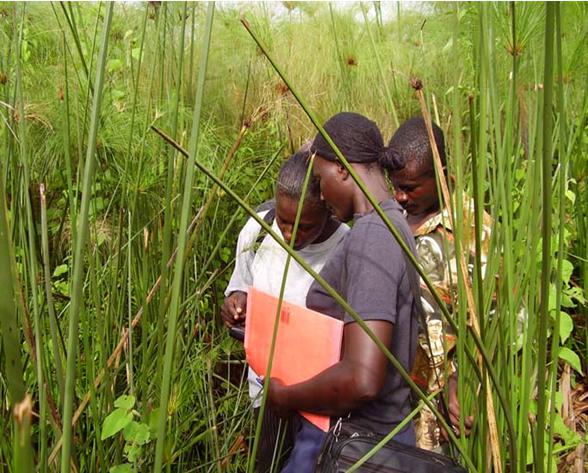Faith Chesire
Other projects
4 Jan 2016
The Conservation Knowledge and Attitudes of Riparian Communities within Nyando Wetland toward the African Clawless Otter
Designed from the first Rufford project’s results, this project seeks to restore connectivity and increase ecosystem resilience that enables habitats and species to move in response to climate change. It will bring out community participation through capacity building that favors landscape connectivity and African clawless otter protection but also profit locals community, develop ways to minimize the risk of their total extinction and establish the preconditions for their invigoration through awareness creation while increasing the reserved networks through rehabilitation that acts as stepping stones connecting the fragmented landscape for conservation of the otters and maintaining the integrity of the wetland.

Project team using GPS to mark coordinates where our monitoring begins.
The facilitation of African clawless otters (ACOt) and other animal species movement in Nyando wetland has been greatly hampered by threats from both fragmentation and habitat loss. These species have continued to face diverse threats of wetland fragmentation. The rampant anthropogenic activities and the longterm threats such as climate change have further increased the patchiness of the landscape in terms of meeting otters’ needs.
Such activities adversely affecting the diversity and population of fish and aquatic organisms that have enormous effects on otter populations in Nyando wetland. Loss of connectivity have reduced the size of and quality of available habitat, impeded, disrupted movement (including dispersal) of otters to new habitats, and affected seasonal migration pattern.
While our earlier RSG-1 supported research, emphasized the need for local knowledge and attitude towards otter conservation, the outcome provides for an urgent need to a systematic conservation based project in Nyando wetlands where the remaining, isolated otter populations have only very little chance to survive. Their distribution in Nyando wetland shows a clear east to west decline. Measures to restore connectivity are therefore increasingly required to increase ecosystem resilience and to enable habitats and species to move in response to climate change.
Designed from the first Rufford project’s results, our 2nd RSG seeks to restore connectivity and increase ecosystem resilience that enables habitats and species to move in response to climate change. It will bring out community participation through capacity building that favors landscape connectivity and African clawless otter protection but also profit locals community, develop ways to minimize the risk of their total extinction and establish the preconditions for their invigoration through awareness creation while increasing the reserved networks through rehabilitation that acts as stepping stones connecting the fragmented landscape for conservation of the otters and maintaining the integrity of the wetland.